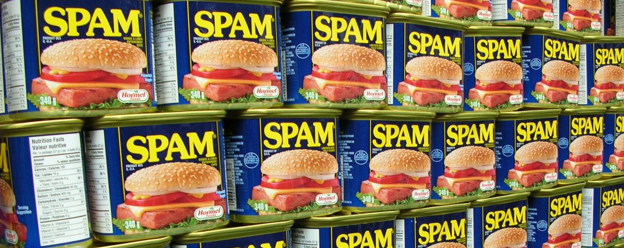- Home
- Friday Column
- What Does SPAM Stand For? From ...

Depending on when you were born, the word “spam” might bring to mind completely different things. If you’re old enough to remember World War II, spam likely stirs up memories of a classic wartime food.
But for most of us, the word brings to mind something far less appetizing—those annoying emails that flood our inboxes, with over 282 billion sent every day.
So, how did we go from a canned ham to the term used for unwanted messages? It’s actually a pretty fascinating story. Let’s explore the surprising connection between that iconic tin of pork, World War II, and how “spam” became the word we use for junk email.
What Does the Word “Spam” Mean?
Spam is a type of communication that is usually unsolicited and sent to many people at once, usually for marketing reasons. As annoying as your boss’s emails can be, we are not talking about those—except your boss is selling the company!
Like ham, not all spam is harmful. Aside from the disturbance, some spam emails are harmless promotions from regular people trying to make a living by selling their products. But other times, spam can be much more dangerous. Some of these emails are phishing attempts designed to trick you into giving away personal information, often while pretending to come from trusted sources, like your bank.
Whether it is fake inheritance scams or shady ads, spam typically looks like this:
You do not want the message
Even if you believe someone might be interested, you should ask them first before sending. Sending without permission is spamming.
They are mass mailings
True spam involves sending the same message to lots of people at once. One-on-one emails aren’t really a problem in most places. However, bulk sending emails without consent crosses the line (and, in many places, the law).
The sender is unknown
Spam emails typically lack any sense of personal connection—they’re not trying to get to know you or build a relationship.
The Origin of the Word “Spam”
Before the Internet came along, spam was simply a brand name. Back in 1937, Hormel Foods, an American company, introduced a canned ham product and named it “SPAM.”

Interestingly, nobody knows for a fact what SPAM really means since the company has never officially explained it. Some people claim it means “Scientifically Processed American Meat” (sounds a bit too serious). However, most people think SPAM is short for “spiced ham” (SP+AM).
The convenience and extended shelf life of this canned meat made it an indispensable food item for both troops and civilians throughout WWII.
Well, the story gets interesting; we promise!
As the canned ham became popular, a popular comedy group did a sketch (more like a skit) on it. In the Spam sketch, a couple visits a café where nearly every item on the menu includes SPAM (the canned meat product).
A bunch of rowdy Vikings in a café, of all places. They’re not pillaging—they’re singing “Spam, Spam, Spam, Spam!” over and over again. The waitress, meanwhile, is struggling to tell them to keep quiet.
It’s absolutely ridiculous, right? That’s the whole point. The more they chant “Spam,” the funnier and more absurd it gets.
Up until this moment in history, no one—not even the actors—knew spam was going to be a thing. All they knew was that spam was everywhere, and it was starting to get annoying—like the spam of today.
Wait, it gets more interesting from here. But before we continue, let’s take a little trip back in history.
When Did Spamming First Start?
If you give a deep thought, you will see that the concept of spamming is not exactly limited to emails. Like the Vikings, it’s safe to say people who talk too much without even asking if you are interested are spammers. As such, the earliest versions of spam, even though they were messages, were not emails.
That brings us to a story from 19th century Britain involving a dentist who embraced what we might call “analog spam.” In 1864, this enterprising (or perhaps overzealous) British dentist decided to promote his services by sending out telegrams to potential clients.
Of course, like spam today, his messages were met with serious disdain.
For you to understand, here is a copy of someone’s complaint about the message published by the Times of London in 1864.
Over 150 years after this letter was written, we can all agree that we feel the pain of whoever M.P. was.
While little is known about the dentist who sent the “viral” telegrams, there is one guy who takes the credit for spam emails.
Gary Thuerk, the first email spammer
Meet Gary Thuerk, the accidental creator of spam emails. Back in 1978, Thuerk was just trying to do his job as a marketing guy at Digital Equipment Corporation (DEC).
The company had new VAX computers to sell, and (unfortunately) it was Thuerk’s job to do the marketing. It seemed like he had gotten that lightbulb moment—why not use ARPANET to spread the word?
Great ideas, they say, start with a thought—same with bad ones. Without a second thought, he prepared his message and sent it to close to 400 people. Little did Thuerk know, he had just sent the world’s first spam email.
ARPANET was used by researchers and scientists for serious business. It had never been used for advertisement of any kind before that time. It was quite understandable that they were shocked when Thuerk’s sales pitch showed up uninvited!
Interestingly, while everyone at the time and even now thinks it was not a good idea, Thuerk believes the idea was marketing genius. According to him, his company made sales worth over $13 million from that spam alone! Today, he is widely celebrated as the father of spam. What a great invention! Or maybe not, as Thuerk has been quoted saying he did not know spamming would get this bad.
But wait a minute, how did unsolicited emails get the name “spam”? We are coming to that in a minute.
While Thuerk was the first “spammer,” it was not until 1993 that the term “spam” became synonymous with unsolicited emails. And that leads us to the next story.
USENET (1993-1994)
You can think of USENET (User’s Network) as a social media platform of the 90s. It was like having Reddit but without memes and cat pictures—a place where geeks and nerds of the day could send and receive messages.
In 1993, one of the tech guys at USENET, Richard Depew, was trying to create a moderation system that could allow admins to delete messages. Little did he know, he was actually creating a bug.
Instead of fixing the problem, his bug created an even worse problem—it started flooding one of the discussion groups with messages.
As USENET’s team tried to fix the issue, users made light of the situation. It was during these exchanges that someone cleverly described the incident as “spamming.” And just like that, a new term was born.
But USENET’s contribution to the spam saga didn’t end there.
USENET had a fundamental design flaw that made it particularly vulnerable to spamming: it allowed users to post to all groups simultaneously. Anyone could post to all groups at once. That’s the equivalent of having email providers today create a send-to-everyone option. You see where this is going?
Fast forward to January 18, 1994. Barely a year after Richard had just fixed his bug, USENET’s vulnerability was exploited when a student decided to play digital town crier. The student posted a message across all newsgroups declaring, “Global Alert for All: Jesus Is Coming Soon.” This act of religious fervor spread far and wide through USENET’s flawed architecture, igniting a firestorm of controversy.
In April of the same year, some lawyers decided to get in on the action. Laurence Canter and Martha Siegel exploited USENET’s flaw by sending lots of advertisement messages about their immigration law services. For lawyers, that’s shameful, right? Nope! These two even wrote a book bragging about it: “How to Make a Fortune on the Information Superhighway.”
Think whatever you will about the lawyers. But then they technically did nothing wrong. It was the early years of the Internet, and there were no strict rules. Canter and Siegel could argue, and indeed did, that they weren’t breaking any explicit rules—because such rules didn’t yet exist.
This was the moment spam evolved from an occasional annoyance to a full-blown marketing strategy. It was like Gary Thuerk’s accidental spam email from years before had come back with a vengeance. Who knew his marketing “oops” would turn into a whole industry?
The Progression of Unwanted Electronic Messages
As the Internet grew, unsolicited mass messaging became more sophisticated. In the 1990s, commercial email marketing exploded, with businesses and individuals using bulk emails to promote everything from legitimate products to fraudulent schemes.
Spam became popular for two reasons. First, it was cheaper than other forms of advertisement (it was practically free). Secondly, anyone with a computer could send an email.
By the early 2000s, spam had become a widespread issue, prompting regulatory responses like the U.S. CAN-SPAM Act (speak of choice of name). Many other countermeasures have been developed, including spam filters. But sadly, the problem persists, evolving to overcome new obstacles.
To Sum Up
The story of spam teaches one big lesson: actions have consequences—sometimes very huge. It is very unlikely that either the dentist or Thuerk saw all these from the past. None of these people could have imagined their messages could grow into such a huge problem that continues to challenge us today.
As a marketer, try not to be like Thuerk; ensure your marketing communications follow all the required ethics and guidelines. For everyone else, we need to stay informed of the danger that can come with spam.



